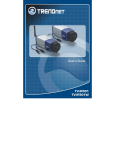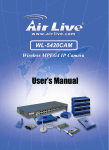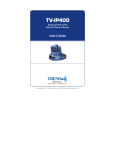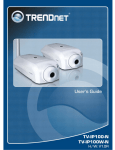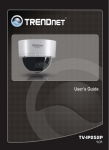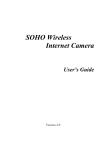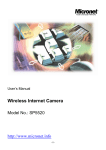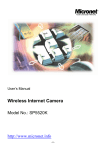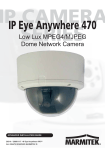Download Digitus Internet Camera
Transcript
Internet Camera User’s Guide Version 2.0 1 TABLE OF C ONTENTS ABOUT THIS GUIDE ...........................................................4 1. INTRODUCTION ..............................................................5 FEATURES AND BENEFITS .........................................................6 UNPACKING THE PACKAGE .......................................................8 SYSTEM REQUIREMENT .............................................................9 PHYSICAL DESCRIPTION ..........................................................10 2. HARDWARE INSTALLATION .................................15 ATTACHING THE CAMERA TO THE STAND ...............................15 CONNECTING THE ETHERNET CABLE ......................................16 ATTACHING THE POWER SUPPLY ............................................16 3. SECURITY.........................................................................17 4. APPLICATION OF THE CAMERA ........................18 5. USING THE CAMERA .................................................21 WEB CONFIGURATION UTILITY...............................................21 SYSTEM ADMINISTRATION ......................................................23 VIEW IMAGE – ACTIVEX MODE ..............................................41 VIEW IMAGE – JAVA MODE .....................................................44 2 6. IPVIEW PRO ....................................................................46 INSTALLATION .........................................................................46 GETTING STARTED ..................................................................50 USING IPVIEW PRO .................................................................53 CONFIGURING THE SYSTEM.....................................................59 7. APPENDIX.........................................................................74 A. FREQUENTLY ASKED QUESTIONS.......................................74 B. PING YOUR IP ADDRESS ....................................................77 C. TROUBLE SHOOTING ...........................................................78 D. TIME ZONE TABLE ..............................................................82 E. ADJUST INTERNET CAMERA FOCUS ....................................84 F. I/O TERMINAL APPLICATION...............................................85 G. SPECIFICATION....................................................................87 H. GLOSSARY OF TERMS .........................................................90 3 A BOUT T HIS G UIDE This manual provides instructions and illustrations on how to use your Internet Camera, includes: z Chapter 1, Introduction, provides the general information on the camera. z Chapter 2, Hardware Installation, describes the hardware installation procedure for the camera. z Chapter 3, Security, explains the security feature of the camera. z Chapter 4, Application of the Camera, provides the illustrations of the camera’s applications. z Chapter 5, Using the Camera, guides you through the configuration using the web browser. z Chapter 6, IPView Pro, helps you to install and use the software. z Chapter 7, Appendix. Please note that the illustrations or setting values in this manual are FOR YOUR REFERENCE ONLY. The actual settings and values depend on your system and network. If you are not sure about the respective information, please ask your network administrator or MIS staff for help. 4 1 I NTRODUCTION Thank you for purchasing the Internet Camera, a camera device that can be connected directly to an Ethernet or Fast Ethernet network. Compared to the conventional PC Camera, the Internet Camera features a built-in CPU and web-based solutions that can provide a cost-effective solution to transmit real-time high-quality video images and sounds for monitoring. The Internet Camera can be managed remotely, accessed and controlled from any PC/Notebook over the Intranet or Internet via a web browser. The simple installation procedures and web-based interface allow you to integrate it into your network easily. With comprehensive applications supported, the Internet Camera is your best solution for remote monitor, high quality, and high performance video images. 5 Features and Benefits Simple To Use The Internet Camera is a standalone system with built-in CPU requiring no special hardware or software such as PC frame grabber cards. The Internet Camera supports both ActiveX mode (for Internet Explorer users) and Java mode (for Internet Explorer and Netscape Navigator users). Therefore, all that is required is a web browser software such as Internet Explorer 5.0 or above or Netscape 6.0 or above. Just plug and view the picture from your Internet Camera with a valid IP Address. Support Variety of Platforms The Internet Camera supports TCP/IP networking, SMTP e-mail, HTTP and other Internet related protocols, and can be utilized in a mixed operating system environment such as Windows, Unix, and Mac. It can be integrated easily into other www/Intranet applications. Web Configuration Applying a standard web browser, the administrator can configure and manage the Internet Camera directly from its own web page via the Intranet or Internet. Up to 32 users name and password are permitted with privilege setting controlled by the administrator. 6 RS-485 Support The pin 1 & 2 of the I/O connectors are used for RS-485 data transmission. You can connect a special featured device (such as an external camera stand with rotation function) to meet you needs. When the external device is connected, you could configure the settings and control the device from the RS485 window of Web Configuration Utility. Remote Utility The powerful IPView Pro application assigns the administrator with a pre-defined user ID and password, allowing the administrator to modify the Internet Camera settings from the remote site via Intranet or Internet. When new firmware is available, you can also upgrade remotely over the network for added convenience. Users are also allowed to monitor the image, and take snapshots. Broad Range of Applications With today’s high-speed Internet services, the Internet Camera can provide the ideal solution for live video images over the Intranet and Internet for remote monitoring. The Internet Camera allows remote access from a web browser for live image viewing and allows administrator to manage and control the Internet Camera anywhere and any time in the world. Apply the Internet Camera to monitor various objects and places such as homes, offices, banks, hospitals, child-care centers, amusement parks and other varieties of industrial and public monitoring. The Internet Camera can also be used for intruder detection; in addition, it can capture still images for archiving and many more applications. 7 Unpacking the Package Unpack the package and check all the items carefully. In addition to this User’s Guide, be certain that you have: One Internet Camera One Installation CD-ROM One Quick Installation Guide One AC power adapter suitable for your country’s electric power One Camera Stand One RJ-45 Ethernet Cable If any item contained is damaged or missing, please contact your local dealer immediately. Also, keep the box and packing materials in case you need to ship the unit in the future. 8 System Requirement Networking 10Base-T Ethernet or 100Base-TX Fast Ethernet. Accessing the Camera For Web Browser Users Operating System: Microsoft® Windows® 98SE/ME/2000/ XP CPU: Intel Celeron 1.1GHz or above (Intel Pentium 4 is preferred) Memory Size: 128MB or above Resolution: 800x600 or above Microsoft® Internet Explorer 5.0 or above For IPView Pro Application Users Operating System: Microsoft® Windows® 98SE/ME/ 2000/XP. CPU: Intel Celeron 1.1GHz or above (Intel Pentium 4 is preferred) Memory Size: 128 MB or above Resolution: 800x600 or above 9 Physical Description This section describes the externally visible features of the Internet Camera. Front Panel 1. Link LED 3. Internal MIC 2.Power LED 1. Link LED The Link LED is positioned on the right side of the Internet Camera’s lens while facing the Internet Camera. It is located to the left of the Power LED A steady ORANGE light confirms that the camera has good connection to LAN connectivity. Dependent on the data traffic the LED will begin to flash to indicate that the Internet Camera is receiving/sending data from/to the network. 10 2. Power LED The Power LED is positioned on the right side of the Internet Camera’s lens while facing the Internet Camera. A steady BLUE light confirms that the Internet Camera is powered on. 3. Internal MIC The built-in omni-directional microphone allows the camera to receive sound and voice. 11 Rear Panel 2. Reset Button 3. I/O Connector 1. Network Cable Connector 4. DC Power Connector 1. Network Cable Connector The Internet Camera’s rear panel features an RJ-45 connector for connections to 10Base-T Ethernet cabling or 100Base-TX Fast Ethernet cabling (which should be Category 5 twisted-pair cable). The port supports the N-Way protocol and “Auto-MDIX” function, allowing the Internet Camera to automatically detect or negotiate the transmission speed of the network. 2. Reset Button Reset will be initiated when the reset button is pressed once, and Power LED begins to flash. Factory Reset will be initiated when the reset button is pressed continuously for three seconds or when Power LED begins to light up. Release the reset button and the Power LED will begin 12 to flash, indicating the Internet Camera is changing to factory reset. When factory reset is completed, the Internet Camera will be set to default on channel 11 and SSID is set as “NULL String” (This default setting will let the Internet Camera connect to ANY access point on the infrastructure network). The IP address will also return to the default setting as 192.168.0.30. 3. I/O Connector The camera provides the I/O connectors on the rear panel (pin 1/2 are for RS485, pin 3/4 are for input, pin 5/6 are for output), which provide the physical interface to send and receive digital signals to a variety of external alarm devices. For more information, refer to Appendix F, I/O Terminal Application. 4. DC Power Connector The DC power input connector is located on the Internet Camera’s rear panel, and is labeled DC5V with a single jack socket to supply power to the Internet Camera. Power will be generated when the power supply is connected to a wall outlet. 13 Top/Bottom Panel Top Panel Screw Hole Bottom Panel Screw Hole Screw Hole Located on the top/bottom panel of the camera, the screw hole is used to connect the camera stand onto the camera by attaching the screw head on the camera stand into the screw hole of the camera. 14 2 H ARDWARE I NSTALLATION Attaching the Camera to the Stand The Internet Camera comes with a camera stand (optional), which is equipped with a swivel ball screw head that can be attached to the Internet Camera's bottom screw hole. Attach the camera stand to the Internet Camera and station it for your application. There are three holes located in the base of the camera stand allowing the Internet Camera to be mounted on the ceiling or any wall securely. 15 Connecting the Ethernet cable Connect an Ethernet cable to the network cable connector located on the Internet Camera’s rear panel, and then attach it to the network. Attaching the Power Supply Attach the external power supply to the DC power input connector located on Internet Camera’s rear panel, and then connect it to your local power supply. TIP: You can confirm power source is supplied from the LED indicators label Power on the Internet Camera is illuminated. 16 3 S ECURITY To ensure the highest security and prevent unauthorized usage of the Internet Camera the Administrator has the exclusive privilege to access the System Administration for settings and control requirements to allow users the level of entry and authorize the privileges for all users. The Internet Camera supports multi-level password protection and access to the Internet Camera is strictly restricted to define the user who has a “User Name” and “User Password” that is assigned by the Administrator. The administrator can release a public user name and password so when remote users access the Internet Camera they will have the right to view the image transmitted by the Internet Camera. NOTE: Since the default settings are Null String, it is highly recommended to set the "Admin ID" and "Admin Password" when you are the first time to use the Internet Camera. Once the ID and Password are defined, only the administrator has the access to management the Internet Camera. This procedure should be done as soon as possible since the security features with the Internet Camera will not be enabled until the "Admin ID" and "Admin Password" is defined. 17 4 A PPLICATION O F T HE C AMERA The Internet Camera can be applied in wide variety of applications. With the built-in CPU, it can work as a standalone system that provides a web-based solution transmitting high quality video images and sounds for monitoring purposes. It can be managed remotely, accessed and controlled from any PC desktop over the Intranet or Internet via a web browser. With the easy installation procedure, real-time live images will be available. In addition, once the Internet Camera is installed coupled with the IPView Pro application, you can further expand the scope of the Internet Camera. The following section will provide the typical applications for the Internet Camera along with the IPView Pro application, and also includes some basic knowledge to assist in the installation and configuration of the Internet Camera. 18 Applications of the Camera z Monitoring of local and remote places and objects such as construction sites, hospitals, amusement parks, schools and day-care centers through the use of a web browser. z Capture single frame images from the IPView Pro application. z Configure the camera to upload image or send mail messages with a single frame image. Home Applications Diagram SOHO Internet Camera SOHO Wireless Internet Camera 19 SOHO Applications Diagram SOHO 20 5 U SING THE C AMERA You can access and manage the Internet Camera through: 1) a web browser, and 2) the enclosed software IPView Pro. This chapter describes the Web Configuration Utility, and provides the instructions on using the camera with a web browser. Web Configuration Utility The Internet Camera must be configured through its built-in Webbased Configuration. (Extensive knowledge of LAN will be helpful in setting up the Internet Camera.) From the web browser, enter the default IP address 192.168.0.30 in the Address bar and then press [Enter] to access the Welcome screen of the Configuration Utility. The Welcome screen is shown on the next page. NOTE: The computer’s IP address must correspond with the camera’s IP address in the same segment for the two devices to communicate. 21 Enter the default IP address Pre-view area Welcome Screen of the Configuration Utility In the Welcome screen, there are three options to choose to set-up and view your Internet Camera, including: z View Image – ActiveX Mode z View Image – Java Mode z System Administration Click System Administration to prompt a login dialog window, and type the default username/ password (admin/admin) in the corresponding boxes. Then, click OK to enter the Configuration Utility. 22 System Administration The Configuration Utility contains eleven options in the top menu bar, including: System, Date/Time, Video/Audio, Network, Users, Trigger, Upload, RS485, Information, Tools, and Home. TIP: Once you have changed the settings in each option, click Save to store the settings, or Cancel to abandon, or Refresh to reload the status. During the configuration, whenever you click Home in the top menu bar will make you return to the Welcome window. System The System window contains the settings for identifying the camera, including Camera Name and Location. Camera Name This field is used for entering a descriptive name for the device. Location This field is used for entering a descriptive name for the location used by the camera. 23 Date/Time The Date/Time window contains commands to set up the camera's time and date, providing correct information to the remote users who might be thousands of miles away from the camera’s location. Date & Time - - Server’s Time: Display the current date/time settings of the camera. TimeZone: Select the time zone for the region from the pulldown menu. (Please refer to the Appendix for the time zone selection table.) Synchronized with Time Server: Select this option and the time will be based on GMT setting. When selecting the option, you have to enter the required information in the following fields: • IP Address - Enter the IP Address of the Time Server in this field. 24 - • Protocol – Select proper protocol: NTP or TIME. Set Manually: This option allows the system administrator to set date/time manually. Select the Change the server’s time and date as below item to enter Date and Time in the respective field manually, or select the Synchronize with this PC item to set up date/time according to the connected PC’s configuration. Video/Audio The Video/Audio window contains commands to control the image and audio settings of the camera. 25 Environment Select Outdoor or Indoor according to the installation location of the camera. Light Frequency Select 60HZ or 50HZ. Video Resolution Select the desired video resolution from three formats: 160x120, 320x240, and 640x480. The higher setting can obtain better quality; however, it will use more resource within your network. Compression Rate Select the desired compression rate from five levels: Lowest, Low, Medium, High, and Highest. The higher compression rate can increase the data transmission speed over the network; however, it will provide poorer image quality. Frame Rate Select the optimal setting depending on your network status. Please note that the higher setting can obtain better quality; however, it will use more resource within your network. The available settings are 1, 3, 7, 12, 15, 25 and 30. Flip Image Select Horizontal to display the image in a horizontal mirror mode. Select Vertical to display the image in a vertical mirror mode. 26 Audio Select the audio format as PCM or ADPCM. Then, you can also adjust the Volume of the camera. In addition, clicking Adjust Image will bring up the following window, which allows you to adjust the image settings: - Brightness: Adjust the brightness level ranging from -64 to +64. Saturation: Adjust the colors level ranging from -64 to +64. Contrast: Adjust the contrast level ranging from -64 to +64. Sharpness: Adjust the sharpness level ranging from -6 to +6. 27 Network The Network window contains commands that allow you to set up networking configuration of the camera. IP Assignment - Use Static IP Address: You can select this option and enter the IP address directly. The default settings are: • IP Address – 192.168.0.30 • Subnet Mask – 255.255.255.0 • Default Gateway – 192.168.0.1 28 - - Obtain IP address automatically via DHCP: If your network uses the DHCP server, select this option. According to this setting, the camera will be assigned an IP address from the DHCP server automatically. Every time when the camera starts up, please make sure that the DHCP server is set to assign a static IP address to your camera. Obtain IP address automatically via PPPoE: If your application requires a direct connection from an ADSL modem through the camera’s RJ-45 LAN port, click this option and enter the User ID and Password into the respective boxes. (Note: You should have an ISP PPPoE account.) The camera will get an IP address from the ISP as starting up. DNS IP Address DNS (Domain Name System) server is an Internet service that translates domain names into IP addresses. Enter at least one DNS IP address. Dynamic DNS Check the Enable Dynamic DNS item to enable the Dynamic DNS function, which allows you to run your domain over a changing IP address. Select one Dynamic DNS provider from the pull-down menu, and then enter the required information in the following fields, including the Domain Name, User Name, and Password. Http port The default HTTP Port is 80. 29 Users The Users window contains commands that allow the system administrator to assign legal users who are permitted to monitor the camera from the remote site. Administrator This field is used for entering the administrator password to access the settings. Enter the password in the Admin Password box, and then enter the same one again in the Confirm Password box to confirm the password. The default setting for Admin is blank space (Null String). For security purpose, you are strongly recommended to set the Admin Password (a maximum of 16 characters) as soon as possible to enable security function for the camera. Add User - User Name: Enter the user name in this field (a maximum of 32 characters, printable ASCII code). A maximum of 32 users names are allowed; however, each users name must be different. Each user name can be used as 30 a group given the password. For example, if the User Name is “Guest” and the User Password is “Guest”, anyone can access the camera with these details used as a group of users under the User Name “Guest”. Delete User Select the user you want to delete from the pull-down menu, and then click Delete. Trigger The Trigger window contains the control settings for external device through the I/O port, and the settings required for e-mail. 31 Enable Trigger Email - SMTP Server Address: To use the e-mail alert function, you must enter the mail server address in the field. Sender e-mail Address: Enter the e-mail Address of sender. Receiver e-mail Address 1/2: Enter the e-mail Address of receiver(s). User Name: Enter the user name in this field to login sender’s mail server. Password: Enter the user password in this field. Sending Interval: Enter the time interval to send next e-mail; the unit is by second. Sending Times: Enter the sending times for every e-mail alert. Send a test e-mail: When completed, you can do a test to confirm the related settings by checking this option. Trigger Output Check the item to enable the camera to receive the signal from specified detection area, and then enter the proper settings in the Time Interval field. Access Control Click the Access Control button to bring up a dialog window that contains list of users, allowing the administrator to assign legal users who are permitted to control the trigger output. 32 Upload To upload the image to FTP server, you need to configure the related settings in the Upload window. FTP Server This field contains the following five basic settings for your FTP server. - Host Address: The IP Address of the target FTP server. - Port Number: The standard port number for the FTP server is Port 21, and it’s also the default setting. If the FTP server uses a specific port, please confirm the IT manager. 33 - User Name: Enter the user name in this field. Password: Enter the user password in this field to login the FTP server. Directory Path: Enter an existing folder name in this field, and the images will be uploaded to the given folder. Operation To enable the FTP upload function, check the Enable upload video to FTP server option, and then configure the following settings according to your necessary. - Always: Allows you to upload the video to FTP server continuously. - Schedule: Allows you to manage the uploading task. In the Schedule option, you can set the Day and Time Period option. • Image Frequency: There are two ways to set the video frequency: 1.) Set the frame(s) per second, or 2.) Set the time for every frame. • Base File Name: Enter the file name to make sure that the images could be saved as the base file name. • File: Since you may not upload only one image to the FTP server, you can choose the filing rule, including Overwrite, Date/Time Suffix, and set up the Sequence Number. 34 RS485 The RS485 window contains the control settings for external device through the I/O port. You have to configure the respective settings in this window. Check the Enable item to enable the function of your camera, and configure the related settings in the following fields. NOTE: When RS485 function is enabled, the system will provide the additional control buttons on the View Image screen (ActiveX mode and Java mode). See the illustrations on page 42 and 45. 35 Port setting Select the proper protocol setting from the two options: Popular protocol command setting or Custom protocol setting. - Popular protocol command setting: Select the proper protocol from the pull-down menu. Click the Preset Position button to bring up a control window, which allows you to control the camera with more options. Arrow buttons • • • Arrow buttons: Use these buttons to move the camera’s lens to your desired position. Click the center button to return to the default home position. Current Position: When you move the camera’s lens to your desired position, assign the position by entering a name (a maximum of 16 characters) in this box, then click Add. The position will be saved in the Preset Position with a number. Preset Position: When you have saved position(s) in the camera, select the position number from the pull-down list; the camera’s lens will move to the position immediately. You can use the Add and the Delete buttons to add/remove the preset position(s). You can save up to 8 positions. 36 - Custom protocol setting: Selecting this field allows you to configure the commands protocol manually. You can click Test to test each command that you have assigned. In the Name and Command String boxes, you can customize more buttons for your needs. Please note that the setting values in the Command String boxes should be from the connected external device (please refer to the manual of connected device). 37 Information The Information window provides general information of the camera, including the Model name, Firmware Version, Mac Address, and IP Address. Model The camera’s model name will be display here. Firmware Version The field displays the firmware version of the camera. MAC Address This field displays the MAC Address of the camera. IP Address This field displays the IP Address of the camera. 38 Tools The Tools window contains commands for restarting the camera and upgrading firmware. Reboot Do you really want to reboot this device? Click YES from this option, and you can restart the camera just like turning the device off and on and saved settings are retained. Factory Reset Do you really want to factory reset this device? Click YES from this option, and you can resume all factory default settings for the camera. NOTE: You have to configure the network settings again after a Factory Reset. 39 LED Control The LED control allows user to setup the LED illumination as desired. This feature provides the flexibility when surveillance activity is ON. There are three options: Normal, ON, and OFF. Update Firmware This option allows you to update the firmware of the camera once you obtained a latest version of firmware. Click Browse to find the firmware file saved in your computer, and then click Update. NOTE: It will take a few minutes to update firmware. Please wait to complete the procedure; you can then reboot the camera. Once the configuration is completed, click Home to return to the Welcome screen and select the desired View Video option either through ActiveX Mode or Java Mode as described in the next section. Then, position the camera to the desired location appropriately for your purpose. Followed by adjustment of the camera focus, done manually by turning the lens clockwise or anti-clockwise to the desire image quality. Please refer to Appendix E for detailed instruction. 40 View Image – ActiveX Mode To view video images from the browser, click View Image ActiveX Mode from the Welcome screen to access the video images from Internet Explorer as illustrated below: Camera Name/Location: The Camera name and location will be displayed when the Camera Name/Location fields are entered in the Web Configuration Utility. Video/Audio: You can enable/disable the video and audio function by clicking the desired selection. Trigger Out: you can turn on/off the output device manually by clicking the OFF button. Browse/Capture: Allow you to capture and save the video image. At Active X mode: the “Browse” function can select path. The 41 "Capture" function can capture and save image into the selected path, and the file name is given automatically. When you enable RS485 function of the camera, the system will provide the additional control buttons on the screen (as show below). You can use the Up, Down, Left, and Right buttons to move the camera’s lens to your desired position. Click the Home button to return to the default home position. When you select Popular protocol command setting in RS485 configuration window (see page35), you can use the Preset Position pull-down menu to select one position, then click Go To to move the camera’s lens to your desired position. 42 If you select Custom protocol setting in RS485 configuration window (see page35), you can use the Custom Command pulldown menu to select one position, then click Go To to move the camera’s lens to your desired position. NOTE: In the View Image screen (ActiveX mode and Java mode), Preset Position will be unavailable when you select to use Custom Command. 43 View Image – Java Mode To view video images from the browser, click View Image – Java Mode from the Welcome screen to access the video images from Internet Explorer or Netscape browser as illustrated below: Camera Name/Location: The Camera name and location will be displayed when the Camera Name/Location fields are entered in the Web Configuration Utility. Video/Audio: You can enable/disable the video and audio function by clicking the desired selection. Trigger: you can turn on/off the output device manually by clicking the OFF button. 44 Browse/Capture: Allow you to capture and save the video image. At Java mode: the "Browse" function includes path selection and file name input. And the "Capture" function includes path selection, file name input and image capture and save. When you enable RS485 function of the camera, the system will provide the additional control buttons on the screen (as show below). The function of these control buttons are the same as they are in ActiveX mode screen (see page 42). 45 6 IPV IEW P RO This chapter describes IPView Pro, which is a powerful software application designed with a user-friendly interface for ease of control and navigation requirements. Installation Step 1 Insert the CD-ROM into the CD-ROM drive to initiate the autorun program. The menu screen will appear as below: 46 Step 2 Click the IPView Pro item to activate the InstallShield Wizard. Click Next in the welcome screen. Step 3 Read and accept the License Agreement; then, click Yes. Step 4 47 Choose the destination location. If no specific requirement, leave the default setting and click Next. Step 5 The InstallShield Wizard starts to install the software, and the progress bar indicates the installation is proceeding. Step 6 48 If you use Windows® 2000/XP, it will appear a Digital Signature warning screen. Click Continue Anyway (Windows® XP) or Yes (Windows® 2000). Windows® XP Windows® 2000 Step 7 Click Finish to complete the installation. 49 Getting Started This section describes the User Interface of IPView Pro, with detailed procedures for using the application. To launch IPView Pro, click Start > Programs > IPView Pro > IPView Pro. The main screen will appear as below: NOTE: IPView Pro requires the system’s resolution setting up to 1024x768. Please configure the resolution to 1024x768 or higher; otherwise, it may shows incomplete screen when launching the program. 50 Item Feature NO. 1 2 Item Date/Time Description Show current date/time. Status Mode Window Show the camera’s status in this window. Click the Change Status Mode button ( ) on the right lower corner of the window to change the display mode: Camera list mode Camera information mode 3 View Window Show the camera’s view in this window. 4 Connect/ Disconnect Click to connect/disconnect the camera. 5 Rotate image angle Click to rotate the image shown in the View Window. 6 Snapshot Click to capture a still image from the View Window. 7 Audio ON/OFF Click to turn on/off the camera’s audio. 8 Zoom Mode Click to zoom in/out the image in the View Window. 9 View Mode Buttons Select the view mode from these buttons. Show one camera in View Window. Show four cameras in View Window. 51 Show six cameras in View Window with the first one as the major view. Show eight cameras in View Window with the first one as the major view. Show nine cameras in View Window. Show ten cameras in View Window with the first two as the major views. Show thirteen cameras in View Window with the first one as the major view. Show sixteen cameras in View Window. Show the selected camera in full screen view. Enable displaying the video views in circles. 10 Key Lock Button Click to lock/unlock the camera. When locked, the user cannot operate any camera. 11 Power Button Click to exit or minimize IPView Pro. 12 Record Button Record video clip of the selected camera and save it in the computer. The storage position can be configured in System Configuration. When you click the button, you can select Manual Record, Schedule Record, or Motion Record. 13 Play Button Play the recorded video file in the computer. Click to enter the System Configuration. 14 System Configuration 52 Using IPView Pro Adding a Camera To add a camera: 1. Click the System Configuration button to enter the System Configuration. If you are not sure of the camera’s IP address, you can click Search to search the available camera(s) within the network. 53 2. Select the camera you want by highlighting it, and then click Add Camera. The camera is added. Click the Add Camera button. The camera found within the network. 3. Click Save, and then click the System Configuration button to return to View Window. The selected camera’s video will be displayed now. You can click Save as to save the selected cameras into the desired path and the selected cameras can be reloaded by load button. 54 Alternately, you can add a camera by entering the its IP address directly: 4. Select the Input IP tab. The camera is added. Click the Add Camera button. Enter the camera’s IP address and Port. 5. Enter the camera’s IP address (default: 192.168.0.30) and Port (default: 80), and then click Add Camera. 6. Click Save, and then click the System Configuration button to return to View Window. The selected camera’s video will be displayed now. 55 Removing a Camera To remove the camera from the list: 1. Select the camera you want to remove. 2. Click Delete Camera. 56 Viewing a Camera From the View Modes of the panel, you can select one-camera mode or other modes to display your video. IPView Pro allows a maximum of 16 cameras for viewing. For example, if you use only one camera, select one-camera ), and the View Window will display the view as mode ( figure 1. ), If there are four cameras, select four-camera mode ( and the View Window will display the view as figure 2. Figure 1 Figure 2 Recording Video IPView Pro allows you to record the video clip and save it in your computer through the following methods: Manual Record, Schedule Record, and Motion Record. When you click the Record button and select Manual Record, it will start recording. Click the button again to stop. If you select Schedule Record or Motion Record, the system will record the video clip according to the settings in System Configuration. 57 Playing Recorded Video The recorded video clips are saved in your computer, and can be played using Windows Media Player. To start playback, simply click the Play button on the panel, and the following dialog screen will appear, allowing you to select the file to playback. Select one file to playback. The folder that stores the recorded file. Select the recorded file in the computer, and then click OK. 58 Configuring the System Clicking the System Configuration button on the panel allows you to configure the system settings, and the System Configuration Screen will appear in the View Window as shown below. Once configured, click Save to save the settings, and then click the System Configuration button again to exit configuration. System Configuration Screen 59 Camera Configuration In this field, you can add/delete the camera (as described in the previous section). Also, you can configure the following settings: Web Configuration In the left column, selecting the Web Configuration item will launch the Web Configuration Utility in View Window. You can configure these settings according to the description in Chapter 5, Using the Camera. Click Back to exit the Web Configuration Utility. 60 Motion Configuration-1 The Motion Configuration-1 item provides the commands for motion detection control. Before configuring, you should select one camera from the pull-down menu. Select one camera. Select Custom region. Region 1. Region 2. - Detect Region: • Full picture – When you select this option, the camera will monitor the whole area. • Custom region – Click Add Region, and then use mouse to draw an area in the view screen; when some motion detected within the area, the camera starts recording automatically. You can set multiple areas in 61 - the view screen. Click Delete Region to remove the area selected. Click Clear All Region to remove all areas in the view screen. Sensitivity Level: Move the slide bar to adjust the sensitivity level for detecting motion to record video. Motion Configuration-2 The Motion Configuration-2 item allows you to configure to the alarm and e-mail setting. - Invoke Alarm: Select this option to enable alarm when some motion detected by the system. 62 - - - Send e-mail: When this option is checked, click the Mailing Configuration in the left column to enter the required information (see the following section). Play music: You can use the music file to alert the event. Click Browse music file to select the desired music, and set the Interval time. Trigger1 active: You can check this option to set the Trigger-On holding time. Tools The Tools item allows you to configure to the alarm and e-mail setting. 63 - - - Reset: Restore the original setting of your camera. Do you really want to reset this device? Click Yes in the pop-up dialog box to confirm. Factory Reset: Restore the factory default settings of the camera. Do you really want to factory reset this device? Click Yes in the pop-up dialog box to confirm. Update Firmware: When new firmware is available, you can upgrade it using this option. Click Browse to find the firmware file, and then click Update. 64 Mailing Configuration When Motion Detection function is enabled and the Send e-mail option is checked, you should enter the required information in the respective fields. - Mail Server: Enter the mail server address that is used to send your e-mail. Mail From/To: Enter the sender’s/receiver’s e-mail address. Subject: Enter the title of the e-mail. User Name/Password: Enter the user name/password to login the mail server. Interval Time: Enter a number in this box to setup the time (in second) to send e-mail regularly. 65 Proxy Server Check the Proxy Server option and enter the required settings in the Address and Port boxes to enable and use the Proxy Server function. 66 Recording Configuration In this field, you can configure the storage settings. - Log Storage: • Reserved HDD Space For MS-Windows OS – You can reserve 500 MB to 10000 MB hard disk space for the program. • Each Recording File Size – If the recorded video files reach the file size limit, video images will be recorded into another file automatically. The available settings are from 10 MB to 50 MB. • Storage List – The destination folder to save the recorded video file can be specified here. Click Modify to change the current path setting; click Add to add a new 67 - - destination folder; click Delete to remove a selected path setting. Please note that you are not allowed to delete a path setting if there is only one setting in the list. Recycle: You can check this option to clear the files when the unreserved space of your hard disk is filled. The available settings are from 200 MB to 50000 MB. Resume last time’s state of recording: You can check this option to store the recording state, and resume the recording state on the next time you record. Schedule-Recording Configuration This recording function will work after you have enabled respective settings in the Schedule mode. The recording schedule can be defined by Date Mode or Week Mode. 68 - Date Mode: First, select the camera desired from the pulldown menu. Then, setup the time in the Start/Stop fields. Click Add to add the recording schedule to the list. Click Save to save the settings. Weekday buttons. - Week Mode: First, select the camera desired from the pulldown menu. Then, setup the time in the Start/Stop fields, and select the weekday from the buttons. Click Add to add the recording schedule to the list. Click Save to save the settings. 69 Others When multiple cameras connected, this option allows the system to display these views as the main view in circles according to your time settings. The range of Time interval of scan is from 1 to 20 seconds. 70 Log List This filed displays the user(s) information, which include the Date, MAC address, and the brief description of events. 71 Account This filed allows you to set the Admin ID and Admin Password. You can also check the Login password check option to secure your camera by checking the login password. 72 About This filed provides information of the software application. 73 7 A PPENDIX A. Frequently Asked Questions Internet Camera Features Q: What is an Internet Camera? A: The Internet Camera is a standalone system connecting directly to an Ethernet or Fast Ethernet network. It is different from the conventional PC camera, the Internet Camera is an allin-one system with built-in CPU and web-based solutions providing a low cost solution that can transmit high quality video images for monitoring. The Internet Camera can be managed remotely, accessed and controlled from any PC/Notebook over the Intranet or Internet via a web browser. Q: What is the maximum number of users that can be allowed to access the Internet Camera simultaneously? A: Maximum number of users that can log onto the Internet Camera at the same time is 64. Please keep in mind the overall performance of the transmission speed will slow down when many users are logged on. 74 Q: What algorithm is used to compress the digital image? A: The Internet Camera utilizes the JPEG image compression technology providing high quality images for users. JPEG is adopted since it is a standard for image compression and can be applied to various web browser and application software without the need to install extra software. Internet Camera Installation Q: Can the Internet Camera be used out-doors? A: The Internet Camera is not weatherproof. It needs to be equipped with a weatherproof case to be used outdoors and it is not recommended. Q: What network cabling is required for the Internet Camera? A: The Internet Camera uses Category 5 UTP cable allowing 10 Base-T and 100 Base-T networking. Q: Can the Internet Camera be setup as a PC-cam on the computer? A: No, the Internet Camera is an Internet Camera used only on Ethernet and Fast Ethernet network. Q: Can the Internet Camera be connected on the network if it consists of only private IP addresses? A: The Internet Camera can be connected to LAN with private IP addresses. Q: Can the Internet Camera be installed and work if a firewall exists on the network? 75 A: If a firewall exists on the network, port 80 is open for ordinary data communication. However, since the Internet Camera transmits image data, the default port 8481 is also required. Therefore, it is necessary to open port 8481 of the network for remote users to access the Internet Camera. 76 B. PING Your IP Address The PING (Packet Internet Groper) command can determine whether a specific IP address is accessible by sending a packet to the specific address and waiting for a reply. It can also provide a very useful tool to confirm if the IP address conflicts with the Internet Camera over the network. Follow the step-by-step procedure below to utilize the PING command. However, you must disconnect the Internet Camera from the network first. Start a DOS window. Type ping x.x.x.x, where x.x.x.x is the IP address of the Internet Camera. The succeeding replies as illustrated below will provide useful explanation to the cause of the problem with the Internet Camera IP address. 77 C. Trouble Shooting Q: I cannot access the Internet Camera from a web browser. A1: The possible cause might be the IP Address for the Internet Camera is already being used by another device. To correct the possible problem, you need to first disconnect the Internet Camera from the network. Then run the PING utility (follow the instructions in Appendix B - PING Your IP Address). A2: Another possible reason is the IP Address is located on a different subnet. To fix the problem, run the PING utility (follow the instructions in Appendix B - PING Your IP Address). If the utility returns “no response” or similar, the finding is probably correct, then you should proceed as follows: In Windows 95/98/2000 and Windows NT, double check the IP Address of the Internet Camera is within the same subnet as your workstation. Click “Start”, “Setting”, “Control Panel”, and the “Network” icon. Select TCP/IP from the “Network” dialog box and from the “TCP/IP Properties” dialog box click “Specify an IP address”. If the Internet Camera is situated on a different subnet than your workstation, you will not be able to set the IP address from this workstation. To verify make sure the first 3 sections of the IP address of the Internet Camera corresponds to the first 3 sections of the workstation. Therefore the IP address of the Internet Camera must be set from a workstation on the same subnet. A3: Other possible problems might be due to the network cable. Try replacing your network cable. Test the network interface of 78 the product by connecting a local computer to the unit, utilizing a standard Crossover (hub to hub) Cable. If the problem is not solved the Internet Camera might be faulty. Q: Why does the Power LED not light up constantly? A: The power supply used might be at fault. Confirm that you are using the provided power supply DC 5V for the Internet Camera and verify that the power supply is well connected. Q: Why does the Link LED not light up properly? A1: There might be a problem with the network cable. To confirm that the cables are working, PING the address of a know device on the network. If the cabling is OK and your network is reachable, you should receive a reply similar to the following (…bytes = 32 time = 2 ms). A2: The network device utilized by the Internet Camera is not functioning properly such as hubs or switches. Confirm the power for the devices are well connected and functioning. Under infrastructure mode make sure the SSID on the PC/Notebook and the Internet Camera must match with the access point’s SSID. Q: Why does the Internet Camera work locally but not externally? A1: Might be caused from the firewall protection. Need to check the Internet firewall with your system administrator. A2: The default router setting might be a possible reason. Need to double check if the configuration of the default router settings is required. 79 Q: Why does a series of broad vertical white line appears through out the image? A: A likely issue is that the CMOS sensor becomes overloaded when the light source is too bright such as direct exposure to sunlight or halogen light. You need to reposition the Internet Camera into a more shaded area immediately as this will damage the CMOS sensor. Q: There is bad focus on the Internet Camera, what should be done? A1: The focus might not be correctly adjusted for the line of sight. You need to adjust the Internet Camera focus manually as described in Adjust Internet Camera Focus. A2: There is no adaptor fitted with your C-type lens. If you have previously changed the supplied CS-type lens, you may have unintentionally installed a C-type lens without fitting the adaptor first. Q: Noisy images occur how can I solve the problem? A: The video images might be noisy if the Internet Camera is used is a very low light environment. To solve this issue you need more lighting. Q: There is poor image quality, how can I improve the image? A1: A probable cause might be the incorrect display properties configuration for your desktop. You need to open the Display Properties on your desktop and configure your display to show at least 65’000 colors for example at least 16-bit. NOTE: Applying only 16 or 256 colors on your computer will produce dithering artifacts in the image. 80 A2: The configuration on the Internet Camera image display is incorrect. Through the Web Configuration Image section you need to adjust the image related parameter for improve images such as brightness, contrast, hue and light frequency. Please refer to the Web Configuration section for detail information. Q: There are no images available through the web browser? A: The ActiveX might be disabled. If you are viewing the images from Internet Explorer make sure ActiveX has been enabled in the Internet Options menu. Alternatively, you can use the Java Applet for viewing the required images. 81 D. Time Zone Table 82 83 E. Adjust Internet Camera Focus To adjust the focus of the lens, you need to turn the lens slowly in either clockwise or anti-clockwise direction until the desired image appears. DO NOT over turn the lens in either of the directions, as it will be out of focus. NOTE: You can further adjust the Internet Camera's image quality through System Administration – Image of Web Configuration. Please refer to Web Configuration section for further details. Warning Direct exposure to sunlight may cause permanent damage to the CMOS sensor. Therefore do not expose the Internet Camera’s lens directly to sunlight. When operation is required in glaring light environment, it is recommended to use an iris lens. The Internet Camera is designed for indoor usage and if your application requires prolong exposure to sunlight, a sun visor is recommended to protect the Internet Camera. 84 F. I/O Terminal Application Typically used in association with programming scripts for developing applications for motion detection, event triggering, alarm notification via e-mail, and a variety of external control functions. The 6-pin I/O Terminal Block is located on the rear panel and provides the interface to: a photo-coupled switch output, a photo-coupled input, and RS-485 interface. The RS-485 is typically used for pan/tilt/zoom control. Connector Pin Assignment PIN No. 1 2 3 4 5 6 FUNCTION RS-485 (+) or (A) RS-485 (-) or (B) Photo-Relay INPUT (+) Photo-Relay INPUT (-) Photo-Relay OUTPUT (Normal Open) Photo-Relay OUTPUT (Common) SPECIFICATION Compliant to RS-485 Active High voltage 9~40VDC Dropout voltage 0 VDC Close circuit current maximum 70 mAAC, or 100 mADC. Output resistance 30 Ohm. Open circuit voltage maximum 240VAC or 350VDC Monitoring and Controlling By entering http requests in your browser’s URL field, you can: • Monitor the status of digital input • Drive the output switch on or off • Control the speed/position of pan/tilt/zoom motors in a swivel stand or a speed dome camera. 85 Interface Schematic 1. Input device (active control device) has independent power supply. 3 4 2. Output device (load) is driven by external power supply. AC/ DC 5 6 Load 3. RS485 Interface 1 2 PTZ Camera 86 G. Specification Video specification Resolution: Sensor: Lens: Gain control: Exposure: White Balance: 640 x 480 pixel Color CMOS sensor f: 6.0 mm, F: 1.8 Automatic Automatic Automatic Image (Video Setting) Compression: Image frame rate: Compression rate: Frame rate: Video resolution: M-JPEG CIF, QCIF, VGA @ 30fps Support different frame rate for different connections depending on connection bandwidth: Lowest/Low/ Medium/High /Highest Auto/20/15/10/7/4/1 160x120/320x240/640x480 Outdoor/Indoor/50Hz/60Hz Audio MIC Input: Compression: Internal MIC (mono) ADPCM/PCM 87 Hardware Interface LAN Connector: Communication protocol: CPU: RAM: Flash ROM: OS: Power Supply: Power consumption: LED Indicator: I/O port pin assignment: Input: Output: RS-485: One RJ-45 port, 10/100M autosensed, Auto-MDIX HTTP, FTP, TCP/IP, UDP, ARP, ICMP, DHCP, PPPoE, DDNS, SMTP, UPnP ADMtek 5120 16MB 4MB Linux 5VDC/2.5A, 100~240VAC, 50/60Hz 6 Watt max. Power LED (Blue) Activity LED (Orange) 1 set, 2-pin (photo relay; Active High: 9~40VDC; Dropout: 0 VDC) 1 set, 2-pin (photo relay, Close circuit current: 70mA or 100mA; 30Ohm; Open circuit voltage: 240 VAC or 350VDC) Half duplex (to control external pan/tilt device) Software Browser: Application Software: Internet Explorer 5.0 or above; Netscape 6.0 or above IPView Pro 88 OS supported: Microsoft Windows 98SE/ME/ 2000/XP Operating environment Operating temperature: Storage temperature: Humidity: 5OC ~ 40OC -25OC ~ 50OC 5% ~ 95%, non-condensing EMI FCC Class B, CE Class B, VCCI Class B 89 H. Glossary of Terms NUMBERS 10BASE-T 10BASE-T is Ethernet over UTP Category III, IV, or V unshielded twisted-pair media. 100BASE-TX The two-pair twisted-media implementation 100BASE-T is called 100BASE-TX. of A Applet Applets are small Java programs that can be embedded in an HTML page. The rule at the moment is that an applet can only make an Internet connection to the computer form that the applet was sent. ASCII American Standard Code For Information Interchange, it is the standard method for encoding characters as 8bit sequences of binary numbers, allowing a maximum of 256 characters. Address Resolution Protocol. ARP is a protocol that resides at the TCP/IP Internet layer that delivers data on the same network by translating an IP address to a physical address. Audio Video Interleave, it is a Windows platform audio and video file type, a common format for small movies and videos. ARP AVI 90 B BOOTP Bootstrap Protocol is an Internet protocol that can automatically configure a network device in a diskless workstation to give its own IP address. C Communication Communication has four components: sender, receiver, message, and medium. In networks, devices and application tasks and processes communicate messages to each other over media. They represent the sender and receivers. The data they send is the message. The cabling or transmission method they use is the medium. Connection In networking, two devices establish a connection to communicate with each other. D DHCP Dynamic Host Configuration Protocol was developed by Microsoft a protocol for assigning dynamic IP addresses to devices on a network. With dynamic addressing, a device can have a different IP address every time it connects to the network. In some systems, the device's IP address can even change while it is still connected. DHCP also supports a mix of static and dynamic IP addresses. This simplifies the task for network administrators because the software keeps track of IP addresses rather than requiring an administrator to manage the task. This means a new computer can be added to a network without the hassle 91 of manually assigning it a unique IP address. DHCP allows the specification for the service provided by a router, gateway, or other network device that automatically assigns an IP address to any device that requests one DNS Domain Name System is an Internet service that translates domain names into IP addresses. Since domain names are alphabetic, they're easier to remember. The Internet however, is really based on IP addresses every time you use a domain name the DNS will translate the name into the corresponding IP address. For example, the domain name www.network_camera.com might translate to 192.167.222.8. E Enterprise network An enterprise network consists of collections of networks connected to each other over a geographically dispersed area. The enterprise network serves the needs of a widely distributed company and operates the company’s mission-critical applications. Ethernet The most popular LAN communication technology. There are a variety of types of Ethernet, including 10 Mbps (traditional Ethernet), 100 Mbps (Fast Ethernet), and 1,000 Mbps (Gigabit Ethernet). Most Ethernet networks use Category 5 cabling to carry information, in the form of electrical signals, between devices. Ethernet is an implementation of CSMA/CD that operates in a bus or star topology. 92 F Fast Ethernet Fast Ethernet, also called 100BASE-T, operates at 10 or 100Mbps per second over UTP, STP, or fiber-optic media. Firewall Firewall is considered the first line of defense in protecting private information. For better security, data can be encrypted. A system designed to prevent unauthorized access to or from a private network. Firewalls are frequently used to prevent unauthorized Internet users from accessing private networks connected to the Internet, especially Intranets all messages entering or leaving the intranet pass through the firewall, which examines each message and blocks those that do not meet the specified security criteria. G Gateway A gateway links computers that use different data formats together. Group Groups consist of several user machines that have similar characteristics such as being in the same department. H HEX Short for hexadecimal refers to the base-16 number system, which consists of 16 unique symbols: the numbers 0 to 9 and the letters A to F. For example, the decimal number 15 is represented as F in the hexadecimal numbering system. The hexadecimal 93 system is useful because it can represent every byte (8 bits) as two consecutive hexadecimal digits. It is easier for humans to read hexadecimal numbers than binary numbers. I IEEE Institute of Electrical and Electronic Engineers. Intranet This is a private network, inside an organization or company, that uses the same software you will find on the public Internet. The only difference is that an Intranet is used for internal usage only. Internet The Internet is a globally linked system of computers that are logically connected based on the Internet Protocol (IP). The Internet provides different ways to access private and public information worldwide. Internet address To participate in Internet communications and on Internet Protocol-based networks, a node must have an Internet address that identifies it to the other nodes. All Internet addresses are IP addresses IP Internet Protocol is the standard that describes the layout of the basic unit of information on the Internet (the packet) and also details the numerical addressing format used to route the information. Your Internet service provider controls the IP address of any device it connects to the Internet. The IP addresses in your network must conform to IP addressing rules. In smaller LANs, most people will allow the DHCP function of a router or gateway to assign the IP addresses on internal networks. 94 IP address IP address is a 32-binary digit number that identifies each sender or receiver of information that is sent in packets across the Internet. For example 80.80.80.69 is an IP address, it is the closet thing the Internet has to telephone numbers. When you “call” that number, using any connection methods, you get connected to the computer that “owns” that IP address. ISP Internet Service Provider, is a company that maintains a network that is linked to the Internet by way of a dedicated communication line. An ISP offers the use of its dedicated communication lines to companies or individuals who can’t afford the high monthly cost for a direct connection. J JAVA Java is a programming language that is specially designed for writing programs that can be safely downloaded to your computer through the Internet without the fear of viruses. It is an object-oriented multi-thread programming best for creating applets and applications for the Internet, Intranet and other complex, distributed network. L LAN Local Area Network a computer network that spans a relatively small area sharing common resources. Most LANs are confined to a single building or group of buildings. 95 N NAT Network Address Translator generally applied by a router, that makes many different IP addresses on an internal network appear to the Internet as a single address. For routing messages properly within your network, each device requires a unique IP address. But the addresses may not be valid outside your network. NAT solves the problem. When devices within your network request information from the Internet, the requests are forwarded to the Internet under the router's IP address. NAT distributes the responses to the proper IP addresses within your network. Network A network consists of a collection of two or more devices, people, or components that communicate with each other over physical or virtual media. The most common types of network are: LAN – (local area network): Computers are in close distance to one another. They are usually in the same office space, room, or building. WAN – (wide area network): The computers are in different geographic locations and are connected by telephone lines or radio waves. NWay Protocol A network protocol that can automatically negotiate the highest possible transmission speed between two devices. P PING Packet Internet Groper, a utility used to determine whether a specific IP address is accessible. It functions 96 by sending a packet to the specified address and waits for a reply. It is primarily used to troubleshoot Internet connections. PPPoE Point-to-Point Protocol over Ethernet. PPPoE is a specification for connecting the users on an Ethernet to the Internet through a common broadband medium, such as DSL or cable modem. All the users over the Ethernet share a common connection. Protocol Communication on the network is governed by sets of rules called protocols. Protocols provide the guidelines devices use to communicate with each other, and thus they have different functions. Some protocols are responsible for formatting and presenting and presenting data that will be transferred from file server memory to the file server’s net work adapter Others are responsible for filtering information between networks and forwarding data to its destination. Still other protocols dictate how data is transferred across the medium, and how servers respond to workstation requests and vice versa. Common network protocols responsible for the presentation and formatting of data for a network operating system are the Internetwork Packet Exchange (IPX) protocol or the Internet Protocol (IP). Protocols that dictate the format of data for transferors the medium include token-passing and Carrier Sense Multiple Access with Collision Detection (CSMA/CD),implemented as token-ring, ARCNET, FDDI, or Ethernet. The Router Information Protocol (RIP),a part of the Transmission Control Protocol/Internet Protocol (TCP/IP) suite, forwards packets from one network to another using the same network protocol. 97 R RARP Reverse Address Resolution Protocol, a TCP/IP protocol that allows a physical address, such as an Ethernet address, to be translated into an IP address. RJ-45 RJ-45 connector is used for Ethernet cable connections. Router A router is the network software or hardware entity charged with routing packets between networks. S Server It is a simple computer that provides resources, such as files or other information. SMTP The Simple Mail Transfer Protocol is used for Internet mail. SNMP Simple Network Management Protocol. SNMP was designed to provide a common foundation for managing network devices. Station In LANs, a station consists of a device that can communicate data on the network. In FDDI, a station includes both physical nodes and addressable logical devices. Workstations, single-attach stations, dualattach stations, and concentrators are FDDI stations. Subnet mask In TCP/IP, the bits used to create the subnet are called the subnet mask. 98 T (TCP/IP) Transmission Control Protocol/Internet Protocol is a widely used transport protocol that connects diverse computers of various transmission methods. It was developed y the Department of Defense to connect different computer types and led to the development of the Internet. Transceiver A transceiver joins two network segments together. Transceivers can also be used to join a segment that uses one medium to a segment that uses a different medium. On a 10BASE-5 network, the transceiver connects the network adapter or other network device to the medium. Transceivers also can be used on 10BASE-2 or 10BASE-T networks to attach devices with AUI ports. U UDP The User Datagram Protocol is a connectionless protocol that resides above IP in the TCP/IP suite ULP The upper-layer protocol refers to Application Layer protocols such as FTP, SNMP, and SMTP. User Name The USERNAME is the unique name assigned to each person who has access to the LAN. Utility It is a program that performs a specific task. UTP Unshielded twisted-pair. UTP is a form of cable used by all access methods. It consists of several pairs of wires enclosed in an unshielded sheath. 99 W WAN Wide-Area Network. A wide-area network consists of groups of interconnected computers that are separated by a wide distance and communicate with each other via common carrier telecommunication techniques. Windows Windows is a graphical user interface for workstations that use DOS. Workgroup A workgroup is a group of users who are physically located together and connected to the same LAN, or a group of users who are scattered throughout an organization but are logically connected by work and are connected to the same network group. Workstations Workstation refers to the intelligent computer on the user’s desktop. This computer may be an Intel-based PC, a Macintosh, or a UNIX-based workstation. The workstation is any intelligent device a user works from. 100







































































































